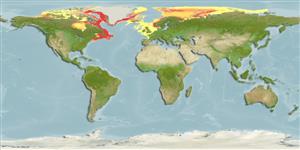Environment: milieu / climate zone / depth range / distribution range
Ekologi
laut batidemersal; kisaran kedalaman 18 - 930 m (Ref. 117245). Deep-water; -1°C - 4°C (Ref. 13534); 83°N - 41°N, 139°W - 141°E (Ref. 117245)
Western Atlantic: western Greenland (Ref. 4695), Hudson Bay and Labrador to Massachusetts (Ref. 7251). Arctic: west of Boothia Peninsula in the Northwest Territories (Ref. 3814) and the northern parts of Kara and Laptev seas (Ref. 4695).
Size / Weight / umur
Maturity: Lm ? range ? - ? cm
Max length : 36.0 cm TL jantan/; (Ref. 7251)
Occurs on soft bottoms (Ref. 13534). Benthic (Ref. 58426). Feeds mainly on epibenthic animals and does not seem to burrow much for prey. Smaller fish prey on smaller species like amphipods, isopods and small bivalves while larger fish prey on shrimps, euphausiids and fish (Ref. 13532).
Life cycle and mating behavior
Kematangan | Reproduksi, perkembang biakan | Pemijahan | telur-telur | Fecundity | Larva
Anderson, M.E., 1994. Systematics and osteology of the Zoarcidae (Teleostei: Perciformes). Ichthyol. Bull. J.L.B. Smith Inst. Ichthyol. 60:120 p. (Ref. 11954)
Status IUCN Red List (Ref. 130435)
ancaman kepada manusia
Harmless
penggunaan manusia
informasi lanjut
AcuanBudidaya airprofil budidaya airStrainGenetikaElectrophoresesDiturunkanPenyakit-penyakitPengolahanNutrientsMass conversion
mitraGambarStamps, Coins Misc.Suara-suaraCiguateraKecepatanTipe renangArea insangOtolithsOtakPenglihatan / visi
Alat, peralatan
laporan khas
muat turun XML
Sumber internet
Estimates based on models
Preferred temperature (Ref.
123201): 1.4 - 7.1, mean 3.5 °C (based on 213 cells).
Phylogenetic diversity index (Ref.
82804): PD
50 = 0.5000 [Uniqueness, from 0.5 = low to 2.0 = high].
Bayesian length-weight: a=0.00309 (0.00192 - 0.00496), b=3.21 (3.07 - 3.35), in cm total length, based on LWR estimates for this species & Genus-body shape (Ref.
93245).
Trophic level (Ref.
69278): 3.5 ±0.53 se; based on food items.
Daya lenting (Ref.
120179): Rendah, Waktu penggandaan populasi minimum 4.5 - 14 tahun (Preliminary K or Fecundity.).
Fishing Vulnerability (Ref.
59153): Low to moderate vulnerability (26 of 100).
